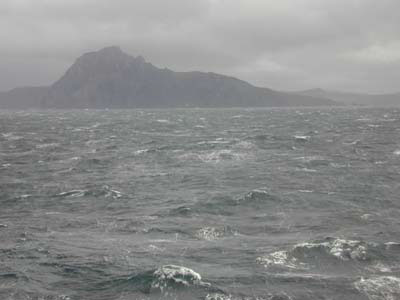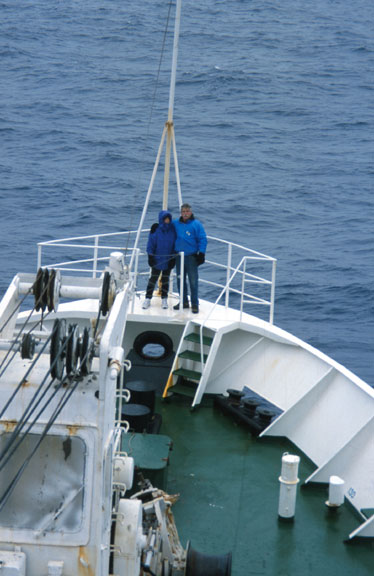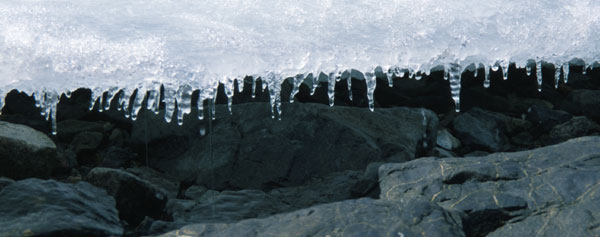Antarctica, Continent of IceIce, Ice Shelves, Tidewater Glaciers, Icebergs, and Sea Ice
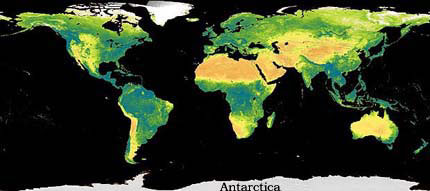 (above) Antarctica is at the bottom of planet Earth. Maps centering on the equator (like this Mercator's projection map) show Antarctica in a highly distorted way. (NASA image)
(right) A south polar view of Earth shows the continent of Antarctica like a large cap (bigger than the United States and Mexico put together) with a peninsula extending northward (toward the tip of South America). This peninsula is called the Antarctic Peninsula and is one of the first places to thaw during the Antarctic summer. (NASA image) |
|
The name Antarctica was originally used over 2,000 years ago - well before any human discovery of Antarctica. The idea that Earth was a sphere was accepted by many of the "thinkers" of this time. One of these "thinkers," Aristotle, postulated that a great land mass had to exist in the southern hemisphere in order to balance all the land in the northern hemisphere. He called this southern land mass "Anti-Arctos," the counterpart to Arctos (the prominent constellation of the northern hemisphere - the Great Bear).
The continent of Antarctica remained a mystery until 1821 when the Antarctic Peninsula was first sighted by either an American (Palmer), an Englishman (Bransfield), or a Russian (Bellingshausen) - there is still debate. Many of the outlying islands were known since the 1700s but, it was not until February of 1821 that the first men are known to have set foot on the continent of Antarctica.
This southern cap of our planet contains 70% of the freshwater and 90% of the ice on Earth. This white continent is the home of the most violent weather on Earth and is the driest, highest, windiest, and coldest of all the continents. There are no hotels or regular air service to Antarctica. Most of the Antarctic winter (June, July) is spent in total darkness (yes, that is 24 hours), with howling winds and storms. There is no personal contact with the outside world during winter except by email, phone, or fax (if available). Summer, on the other hand (December, January) has constant daylight and many (but not all) of the storms subside. Large ice-tolerant vessels do travel to Antarctica during summer months, bringing scientists, support personnel and tourists. Since there are no hotels on Antarctica, all tourists must stay on the vessels that bring them. Many countries have scientific research stations that are homes for the scientists and support personnel.
The ocean around Antarctica runs completely around planet Earth in one direction (to the east). This current is called the West Wind Drift and moves the ocean from west to east around Antarctica. This mixes the southern ends of the Atlantic, Pacific and Indian Oceans and creates a unique oceanic area. Many books do not recognize the presence of a separate ocean around Antarctica (because there is no defining continental outline) but some refer to this area as the "Southern Ocean."
|
| |
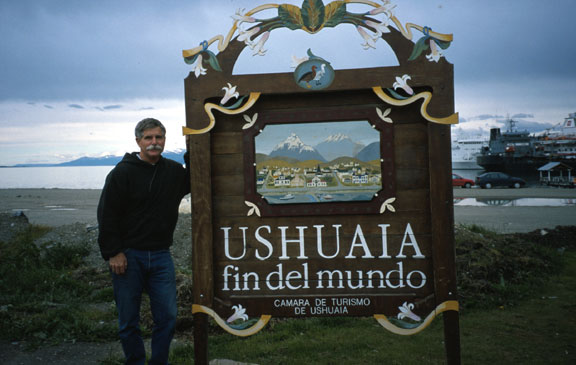 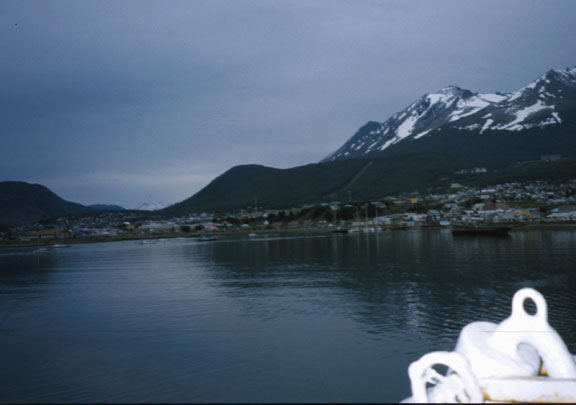 |
(left) The author's husband, at "the end of the world", Ushuaia, Argentina. (right) A view of the City of Ushuaia as we leave Ushuaia, aboard our modified Russian ice breaker, traveling east along the Beagle Channel. The snow-capped Andes Mountains can be seen in the background with a distinct line where the snow has melted for the summer. (GA images)
|
| Ushuaia, Argentina, at 54 degrees 46 minutes south latitude, is claimed by the Argentineans as the southernmost city on Earth. This is where the Andes Mountains (that run in a north/south direction along Chile) turn and run east (for just a short distance) at the end of the range. Ushuaia is on the south side of the Andes, is the capitol of the province of Tierra del Fuego in Argentina, and is renowned for its cross-country skiing. It is 150 km from Ushuaia to Cape Horn (the southernmost tip of South America) and 4,000 km to the South Pole. There were only about 7,000 people in Ushuaia in the early 1990s but by the year 2000 there were over 45,000 due to a governmental promotion to revitalize this area (high wages and no taxes). With a new airport and deep water port, Ushuaia has become the major city for Antarctic departures of the large ice breaker vessels that travel to and from Antarctica.
|
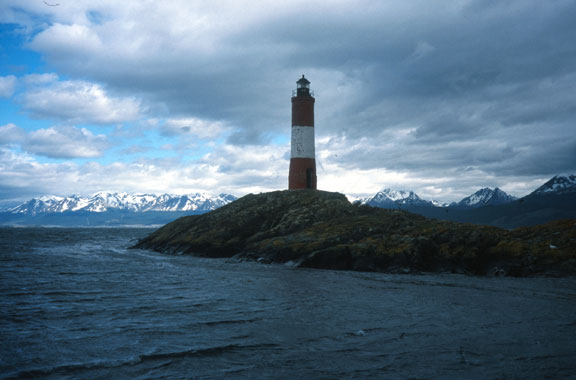 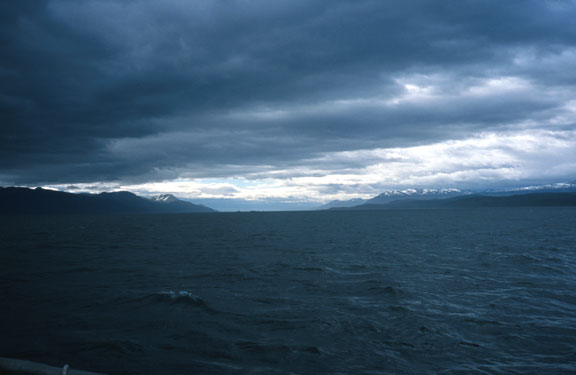 |
(left) The Las Eclaires Lighthouse, an unmanned lighthouse, remains as an historical landmark in the Beagle Channel and an aid to navigation. Most large vessels must be escorted through the Beagle Channel by an Argintinean "pilot boat" as they come and go from Ushuaia. (right) Looking east toward the end of the Beagle Channel, the Atlantic Ocean looms ahead and the dreaded rough Drake Passage. (GA images)
|
The city of Ushuaia looks south, across the Beagle Channel. It was in the mid 1800s that Charles Darwin sailed through here in the now famous vessel, the Beagle (after which this channel is named). Leaving Ushuaia by way of the Beagle Channel the real crossing begins when the vessel enters the Atlantic Ocean, and passes Cape Horn.
|
Cape Horn on an unusually calm day (December 28, 2000). We are within two miles of the Cape. (GA image)
|
| Many of the early explorers lost their lives here at Cape Horn as they attempted to get from the Atlantic Ocean to the Pacific Ocean. There are numerous tales of fighting the wild seas at Cape Horn for days, weeks and even months and still being unable to round the Cape. It is an unusual day that one can venture close to the Cape. |
Starting across the Drake Passage. (GA image)
|
The area between Cape Horn and the Antarctic Peninsula is called The Drake Passage and has some of the roughest ocean waters in the world. The Drake Passage was so rough that the continent of Antarctica was not discovered for a long time because explorers just could not get across it. This passage has an average wind speed of 44 km/hr. and an easterly flow of ocean water (from the West Wind Drift current) that puts 8 times the volume of the Gulf Stream (formerly thought to be the fastest current) through the passage each day. It usually takes 2 full days and nights to get across "The Drake." If the seas are not too high (up to 30 foot swells during the summer) there are seabirds and whales to be sighted. Most passengers must "pay the Drake" during this 48 hours of crossing before they can enjoy the wonders of Antarctica. Occasionally a crossing will not hit any rough seas (only 6-12 foot swells) and the Drake Passage will be called the "Drake Lake."
|
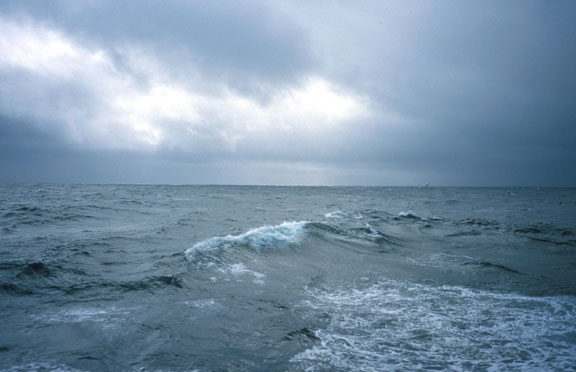 |
The Antarctic Convergence is not very spectacular to look at but the drop in temperature of the ocean water here is a major barrier to life forms that are not adapted to freezing temperatures. (GA image)
|
Antarctica can be defined in three ways. The first way is the outline of the continental land mass and its permanent ice. The second is to use the Antarctic Circle (at latitude 66.5 degrees south) and consider everything south of that latitude to be Antarctica. The third way is perhaps the best for considering the entire Antarctic as an ecosystem - this is to use the Antarctic Convergence as the defining line. The Antarctic Convergence occurs in the ocean surrounding Antarctica and is where very cold (low salinity) Antarctic water, flowing away from the continent and constantly cooled by the ice on the continent, meets with the southernmost parts of the Pacific, Atlantic, and Indian Oceans. The Antarctic water is denser, because it is so cold, and sinks, creeping north across the ocean bottoms. South of this convergence not only is the ocean water colder but the air is distinctly colder and drier than north of the convergence. Most of the life forms found in Antarctica depend on the ocean within the Antarctic Convergence so using this as a definition for Antarctica encompasses the entire physical area that is important for the complex ecosystem that is found there. The convergence moves north during the Antarctic winter, and south in the Antarctic summer - in response to the freezing and thawing of the sea ice. This Convergence is a biological barrier to organisms both in the ocean and the air because of the big temperature difference.
Ice |
|
As the driest continent, Antarctica is actually a place of low precipitation (rain, snow) but intense cold. In general, the air is much colder than the ocean water. The ocean water is usually between a +5 and -2 degrees Centigrade but the air may be well below -2 degrees Centigrade. It is like a desert (in the sense that there is little precipitation) however, any precipitation that does fall rarely melts and adds to the polar ice cap. The south polar ice cap receives only 2 inches of precipitation each year (more than some deserts). The accumulated ice never melts, is over 15,000 feet thick in some areas, and depresses the continental land mass under its weight (over 2,000 feet in some areas). The bottom of this ice pack may be over 100,000 years old and holds a record (layer by layer) of the history of earth with each layer.
(right) The Antarctic Ice Sheet pushed toward the edge of the continent. (GA image)
|
|
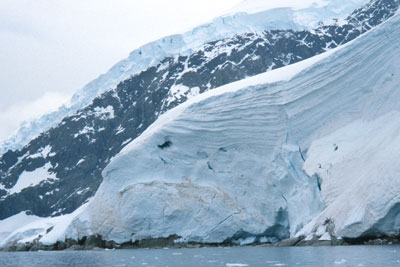 |
As layers of frozen snow and ice crystals build up (left) (from any moisture in the air), the pressure from the cap pushes out toward the ocean, squeezing the ice between a few of the tall mountains that still protrude. In many areas this ice movement is much like a river (although in slow motion as flowing ice rather than flowing water) and called a glacier. Usually the glaciers meet the ocean as tidewater glaciers or as ice shelves. Although over 98 percent of the continent of Antarctica is covered in ice there are a few areas without ice (some unique dry valleys where there has been no precipitation for 2 million years, and along some of the coastlines during the summer melt). If all the ice in Antarctica were to melt, the oceans would rise 200 feet!! As a result, the continent of Antarctica would rebound (rise) without the weight of the ice and the world would be a very different place. The presence of all the permanent ice in Antarctica makes it the highest continent, with the average elevation at 7,100 feet and large areas in the interior over 13,000 feet. The ice sheet thins as it reaches the edges of the continent melting back during summer and exposing rocky beaches and headlands, or forming ice shelves and tidewater glaciers. (GA image)
|
|
Ice Shelf, above, a permanent part of Antarctica. The shelves never melt back to the continent and are actually mapped as the edge of the Antarctic Continent. (GA image)
|
In some areas of Antarctica the glaciers flow along the continent, toward the ocean in such a manner that they spread out and are relatively flat for some distance on the continent. If these glaciers are thick enough, and not subject to a lot of cracking, they may form permanent ice shelves along the edges of the continent. This is common on either side of the Antarctic Peninsula (the Ross Ice Shelf, to the west, and the Ronne Ice Shelf, to the east). The ice shelves may be grounded near the edge of the continent but are usually floating along their outer edge although the ice may be over 800 feet deep at the edge of shelf. The face of most of the permanent ice shelves is around 100 to 200 feet high. It is very difficult to get ashore along these ice shelves (although not impossible) and it may be dangerous if the shelves are cracking. Some of the largest ice shelves are so permanent that their edges actually show up as the edges of the continent (like the Ross and Ronne Ice Shelves) and some have permanent scientific outposts and/or weather stations established on them. When pieces of these ice shelves crack and break away, they may be very large and have a uniquely flat top (thus they are called table bergs). One of the largest such table berg was the size of the state of Delaware (named the B-15 iceberg, it was 185 by 23 miles) and broke away from the Ross Ice Shelf about March of 2000 changing the outline of the Antarctic continent.
|






